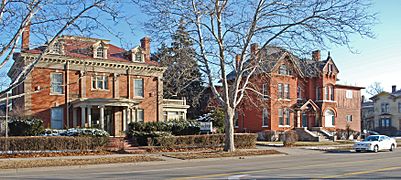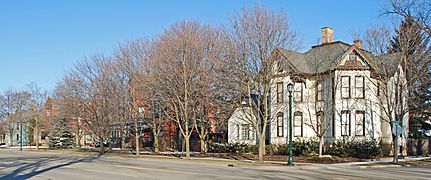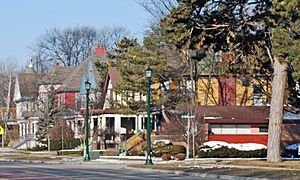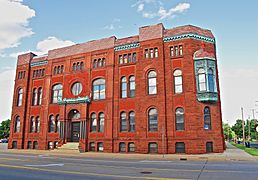Center Avenue Neighborhood Residential District facts for kids
|
Center Avenue Neighborhood Residential District
|
|
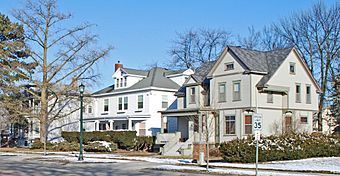
Center, between Pendleton and Trumbull
|
|
| Location | Roughly bounded by N. Madison, Green, & Center Aves., 4th, 5th, 6th, & 10th Sts., Carroll Rd. & Nurmi Dr., Bay City, Michigan |
|---|---|
| Area | 335.3 acres (135.7 ha) |
| Architectural style | Mid 19th Century Revival, Late 19th And Early 20th Century American Movements, Late Victorian |
| NRHP reference No. | 82002826 (original) 12001027 (increase) |
Quick facts for kids Significant dates |
|
| Added to NRHP | April 22, 1982 |
| Boundary increase | December 12, 2012 |
The Center Avenue Neighborhood Residential District is a special area in Bay City, Michigan. It's known for its beautiful old homes, mostly found along Center, Fifth, and Sixth Avenues. This historic neighborhood also stretches to other nearby streets like Fourth, Tenth, and Green Avenues. It's so important that a big part of it was added to the National Register of Historic Places in 1982. Later, in 2012, even more of the neighborhood was recognized for its history.
Contents
A Look Back: How the Neighborhood Grew
Bay City's Early Days
Bay City started growing quickly in the mid-1800s. The first sawmill was built in 1837. By 1854, there were twelve sawmills working. This meant lots of jobs and people moving to the city. By 1870, about 7,000 people lived in Bay City.
This fast growth led to a shortage of places to live. Wealthy families, many of whom made their money in the lumber and salt industries, chose to build their grand homes along Center Avenue. This area was perfect because it was close to the city's main business district but still felt like a quiet, peaceful neighborhood. Most of these homes were built between the 1870s and 1880s.
Changes Over Time
After the year 1900, the lumber industry started to slow down. But new businesses and jobs took its place, like farming, iron factories, and textile (fabric) production. New wealthy business owners continued to build their homes on Center Avenue, often right next to the older houses. The neighborhood kept growing until the Great Depression in the 1930s.
Even after all these years, the Center Avenue district still looks much like it did when it was first built. It has kept its beautiful homes and charming streets.
Protecting History: CANA
In 2005, a group of neighbors decided to work together to protect the history of their area. They formed the Center Avenue Neighborhood Association (CANA). This group helps promote the neighborhood and works with the City of Bay City to keep its history alive.
Exploring the Neighborhood's Architecture
Historic Homes and Buildings
The Center Avenue Neighborhood Residential District has 936 buildings in total. A large number, 879, are considered "historic" because they help tell the story of the neighborhood. These buildings show off many different architectural styles from the past.
Many homes were built from the early 1870s to around 1900. You can see beautiful examples of styles like:
- Italianate: Often has wide eaves and decorative brackets.
- Stick style: Looks like it has wooden "sticks" on the outside.
- Queen Anne: Known for turrets, towers, and decorative details.
- Richardsonian Romanesque: Uses heavy stone and round arches.
- Châteauesque: Looks like French castles with towers and steep roofs.
Later homes, built in the early 1900s (from 1900 to 1930), show off other styles:
- Georgian Revival: Inspired by older, formal English homes.
- Renaissance Revival: Looks like buildings from the European Renaissance.
- Gothic Revival: Reminds you of medieval churches with pointed arches.
- Prairie Style: Has strong horizontal lines and open spaces.
- Arts and Crafts: Focuses on natural materials and handmade details.
- Bungalow: Smaller, cozy homes often with a porch.
The older homes are mostly in the western part of the district. As you move east, you'll see newer homes. Some even include Moderne and Mid-century modern styles from the mid-20th century.
Famous Homes in the District
Many important and beautiful homes stand in this neighborhood:
- James Shearer Residence (701 Center Avenue): A grand Italianate home built in 1876.
- Benjamin Burbridge Residence (1403 Fifth Street): An interesting brick Italianate house from 1884.
- John Gregory Residence (1303 Fifth Street): A Stick style house built in 1879-80.
- William Clift Residence (1409 Sixth Street): A two-story Queen Anne home from 1887.
- Charles Curtiss Residence (924 Center Avenue): One of the grandest homes, a sandstone and wood Queen Anne style house built in 1891.
- Frederick Bradley Residence (1400 Center Avenue): A huge Queen Anne home with a unique design from 1887-89.
- Fremont Chesbrough Residence (1515 Center Avenue): A stone and brick Romanesque home built in 1891-91.
- Henry Clements Residence (1601 Center Avenue): A Chateauesque style home with a steep roof from 1890.
- Thomas Cranage Residence (1001 Center Avenue): A Georgian Revival home with a large front porch, built in 1906.
- Homer Buck Residence (820 Johnson Street): A Prairie Style-inspired home built in 1909.
Public Buildings and Spaces
While mostly residential, the district also has some important public buildings and spaces:
- First Presbyterian Church (805 Center Avenue): A Romanesque building from 1892.
- Bay City Masonic Temple (700 Madison Avenue): A large stone building from 1893, with an addition in 1926.
- Bay City Public Library (708 Center Avenue): A Renaissance Revival-inspired Carnegie library built in 1922.
- First Congregational Church (900 Sixth Street): A Gothic Revival church.
- Trinity Episcopal Church (911 Center Avenue): Built in 1887 in a Gothic Revival style.
- St. Boniface Catholic Church (500 North Lincoln Street): Another Gothic Revival church.
- Madison Avenue M.E. Church (400 Madison Avenue): Built in 1888 in a Gothic Revival style.
- Church of Christ, Scientist (701 North Van Buren Street): Built in 1912 in the Neoclassical style.
- Temple Israel (2300 Center Avenue): Designed by Alden B. Dow and built in 1960.
- Scottish Rite Temple (610 Center Avenue): Built in 1926.
- Farragut School (301 North Farragut Street): An Art Moderne building completed in 1939.
A few commercial (business) buildings are also found within the district.
Gallery





